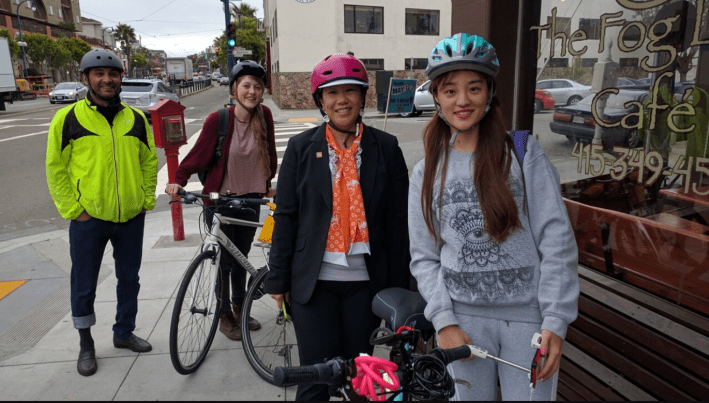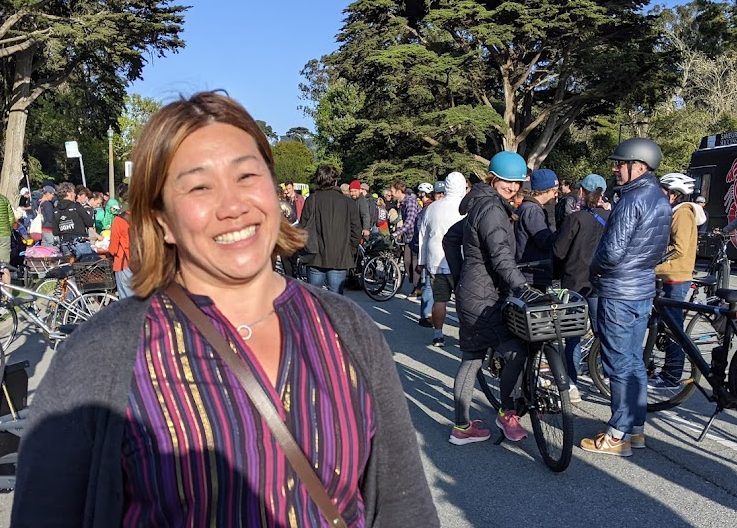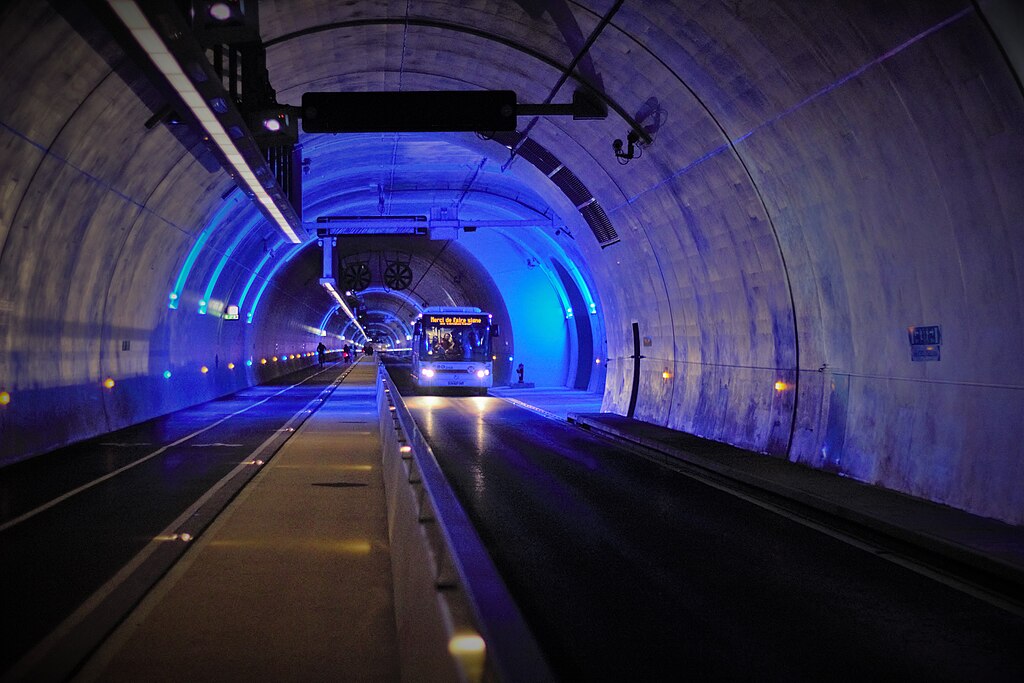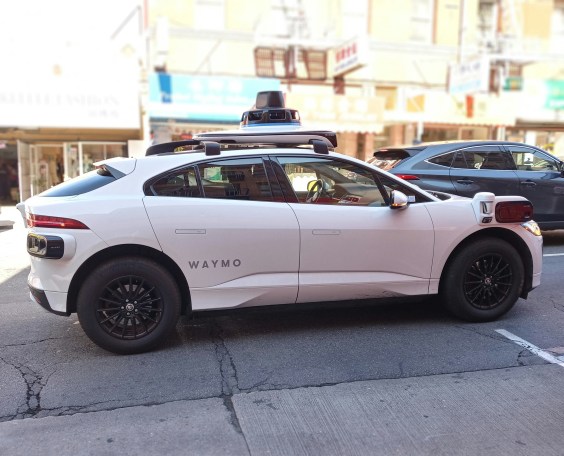Janelle Wong became permanent Executive Director of the San Francisco Bicycle Coalition last month, after serving as its interim director for almost a year. From the SFBC's announcement:
Wong has been on staff at the San Francisco Bicycle Coalition for eight years, working closely in operations and finance, and has most recently served as the organization’s Interim Deputy Director, further demonstrating her readiness for this new position and commitment to our mission. Over these eight years, Janelle has shown extensive skill and knowledge in growing the budget and team capacity of the organization, managing contracts, and increasing revenue to expand our programmatic work.
When asked about the future of the organization, Janelle explained: “When I started working at the San Francisco Bicycle Coalition, there were only 11 staff — now we have 22! I am so thrilled to see how far we’ve come in the last few years, and am enthusiastic about our ability to grow and expand our work in the years to come.”
Streetsblog caught up with Wong at the organization's Market Street headquarters and asked her about the implications of the J.F.K. Promenade victory and other pending developments towards promoting cycling, transit (yes, transit) and safer streets in San Francisco.
***
Streetsblog: What is the significance of car-free JFK in the greater fight for safe cycling in San Francisco?
Janelle Wong: For our organization, it represents decades of advocacy work. Former staff people and former executive directors came to the celebration of JFK. It meant a great deal to them personally. So many hours--it took tens of thousands of hours of advocacy work to make that 1.5-mile stretch of road car-free. For me personally, as a resident, it is a recognition at City Hall and by the supervisors that we need safe spaces not just to recreate but to get around the city. It is the beginning of what we envision of a network of car-light or car-free streets across the city.
SB: The fight for JFK got pretty nasty at times--with accusations that it discriminates against disabled people or is a form of "recreational redlining." How do you deal with such accusations?
JW: Entering this world of advocacy around bicycles, well, people make very aggressive comments. Sometimes I shut off my social media. It's challenging because it feels personal. At some level, you have to say they have their point of view. But we see a great world and great city that we can build for all people who use the roads. It’s not about getting rid of cars. It’s about creating space for other users of the road.
SB: You mean you don't hate cars?
JW: I get that all the time; “well you’re just anti-car.” And I’m like, "I have a car." Most California cities, like L.A., are built for cars, and they make it very challenging to choose other modes of transit on a regular basis.
SB: And you're trying to make it less challenging. So what's the next big fight toward that goal? Getting the long-promised protected lanes on Valencia?
JW: That’s currently on the schedule. The SFMTA has an open house planned for this summer.
SB: You're already looking beyond Valencia?
JW: We want a network for cyclists--and frankly other mobility devices, such as electric scooters. And we want to work on corridors and streets that connect the city all the way across holistically. Like when I got my vaccines I had to go to the Bayview. And riding a bike from the Sunset to the Bayview is not something most folks will be comfortable doing. It's important to reach the southeastern parts of the city and we plan to do thoughtful work on that.
SB: That's pretty fraught territory. Remember Paul Avenue in the Bayview, that had a bike lane removed shortly after it went in? That was a pretty big failure.
JW: The organization has to look at examples like that and change its approach in how we do our advocacy work. Yes, we are a bicycle advocacy organization but in some of the southeastern neighborhoods what’s important to them is safer streets; not necessarily bikes. It could mean generally. Or it could be about essential workers trying to get to work for a night shift. We’re trying a different approach to be better listeners, to approach community organizations that are seen as leaders who want safe streets too. So it's not always about the bike lane; sometimes it’s about pedestrian improvements, it’s about traffic signals and stop signs. I think for us as an organization we have to look beyond the bicycle. It’s there. It’s part of that plan, but it shouldn’t always be the first thing we talk about.
SB: But that still isn't going to sell everyone.
JW: JFK was a good example of a comprehensive process of meeting the needs of different groups. Still, not everybody was happy, but SFMTA did a good job of listening and providing solutions.
SB: Slow streets are an example of something that's also not bike lanes per se but is of great benefit to cyclists and other road users.
JW: It’s a model we can use. Slow streets across the city can form an incredibly important part of a safe bicycle network. I think Page Street is an excellent example of that working.
SB: But slow streets can also be controversial.
JW: We can approach it more from the side; it could be more about street fairs, like Sunday Streets, or block parties.
SB: Because it gives people an idea of how streets can be used for more than just cars... that there are alternatives to cars and traffic?
JW: We always argued if people could just see how amazing not having cars on JFK could be, they’d get it. They’d get why people fight for it. I think that’s true in a lot of different neighborhoods. The Sunset is another example. As a Sunset resident, I get that not everybody wants to ride seven miles on a bicycle. That's why I think a transit-friendly city is also a bike-friendly city. There are times when you don’t want to ride your bike. And there are parts of the city where you can’t. For instance, Treasure Island, where my son plays little league. I take the bus. It's six minutes from the transit center.
SB: Unless there's a wreck on the bridge.
JW: But it's a clear example of why even in households that depend on active transportation, transit is still important.
SB: Because even the hardest-core cyclists sometimes need transit.
JW: Muni running smoothly. Muni getting the finances that it needs to be a reliable and efficient system, actually helps with active transportation. It is key to making this a city that also works for people who want to ride bikes--and for people who don't want to ride bikes and don't have the financial luxury to own and store a car.
SB: So it's less about pushing bikes, and more about giving people options?
JW: It's like Supervisor Dean Preston said about JFK. We’re asking people to use alternate forms of transportation. But we have to make sure alternatives to cars are safe and reliable to use.
SB: Your predecessor, Brian Wiedenmeier, got flack for accepting donations from Waymo and Cruise, driverless car companies. Where do you stand on that?
JW: Brian and I share the same viewpoint. Driverless cars exist and are going to be on our streets. The fact is we'd rather be participating in the development of that technology for the safety of cyclists. We need to have a seat at the table to express our safety concerns. We have the perspective on how to make it better for people on bicycles.

SB: Scooters. When they first hit the scene a few years ago, Walk San Francisco pushed back. Bike East Bay embraced them. The SFBC kept its distance. Where do you stand?
JW: It’s clear that they're growing in popularity. It’s far less costly than a car and in many ways less expensive than an e-bike. They’re not going away. So we have to help educate. They shouldn’t be riding on the sidewalk, but they should use the bike lane like the rest of using e-bikes and bicycles, all in the same space. They are using the same infrastructure and so they need to be a part of that conversation.
SB: But nobody gets to use the infrastructure if there's a truck parked on it, as I saw just outside your office. There's a movement among advocates to push for Parking Control Officers (PCO) to take over the job of enforcement, since it will in theory reduce the potential for discriminatory, pre-textual, and selective enforcement stops. But during a recent demonstration on Valencia for protected bike lanes a PCO wouldn't give a citation to a driver who refused to get out of the bike lane because the PCO was afraid of him. So how does that actually work in practice?
JW: As an organization, we have distanced ourselves from the police department. We believe there can be ways to enforce against traffic violations without involving the police, but I hear what you’re saying. I think the real answer lies in building better infrastructure, so enforcement issues with bike lanes don't come up.
SB: So use concrete to keep motorists out of bike lanes?
JW: That is essentially the point. The infrastructure of our street designs would correct undesirable behavior.
SB: Getting back to your trips to Treasure Island, are we ever going to see a bike lane on the Bay Bridge western span?
JW: They’re building 8,000 units on Treasure Island. That’s a lot of folks to move around. The bike lane may not happen in my lifetime. But I’m hoping for my kids. This next generation gets it. Their vision of a better earth will make those changes and investments happen.





